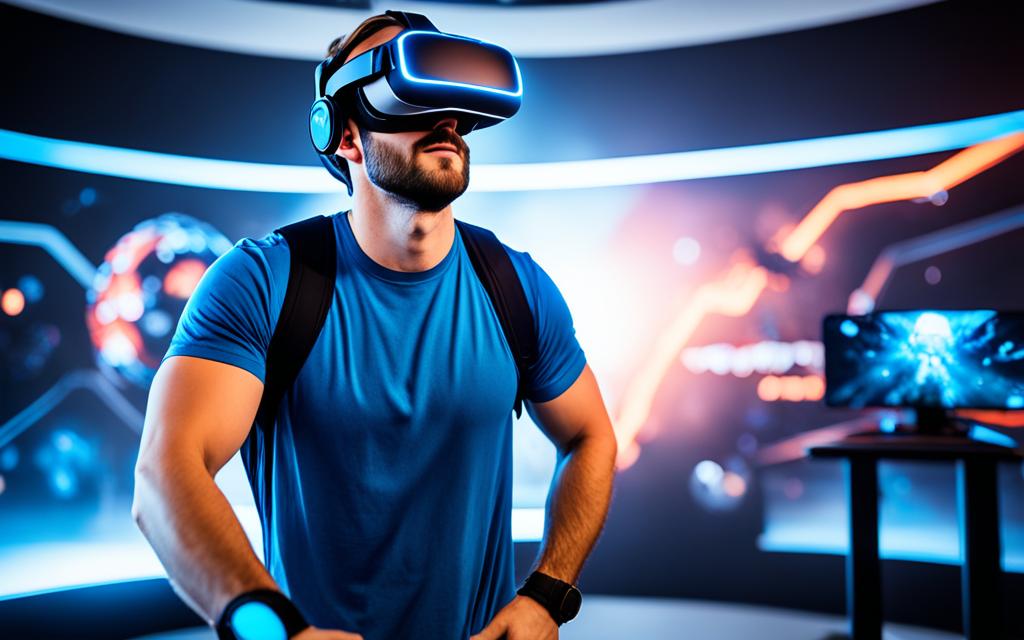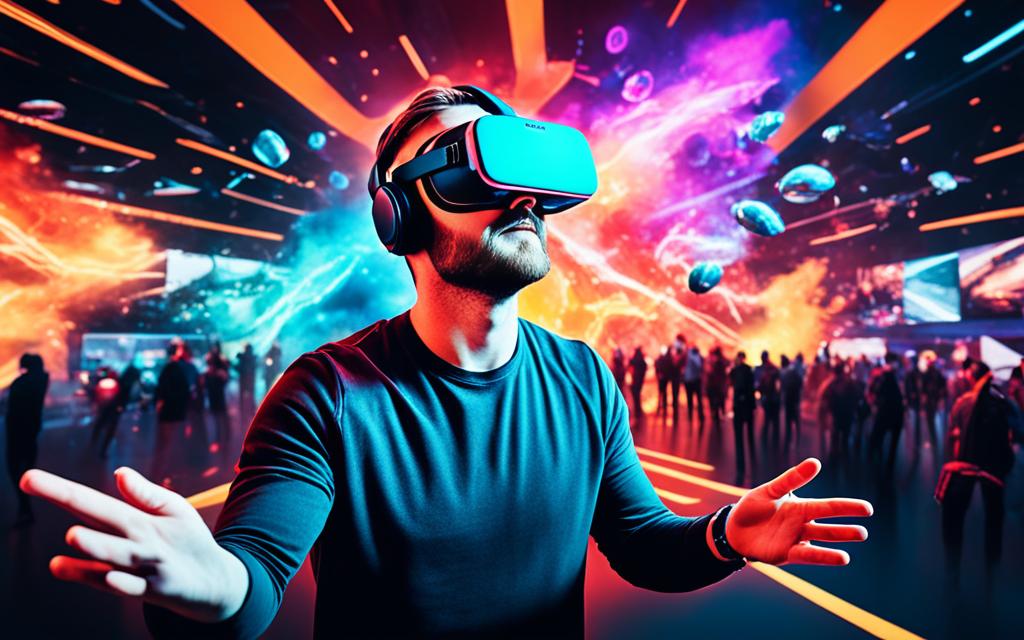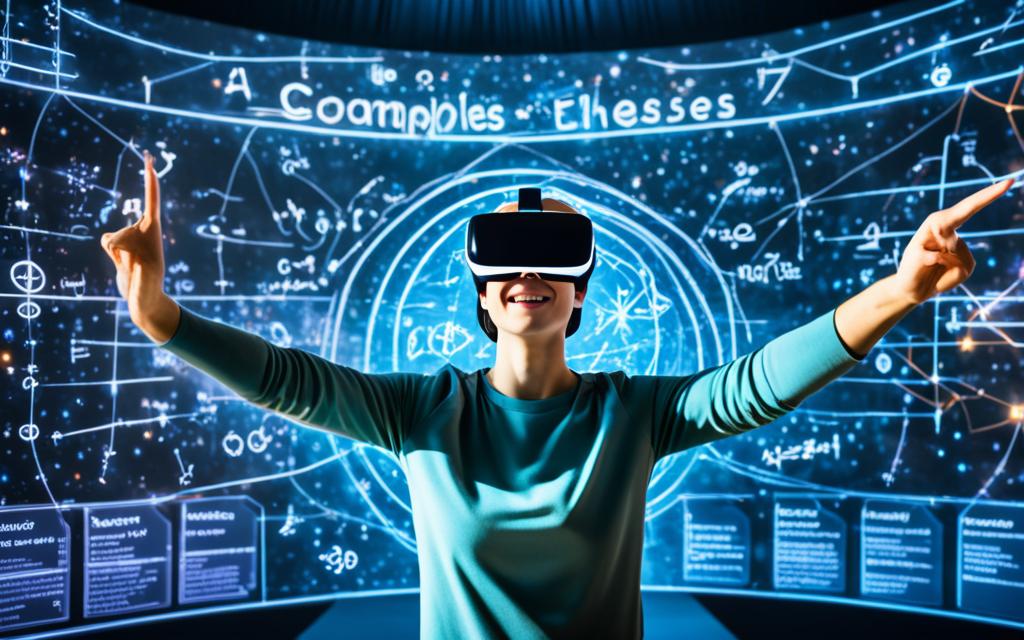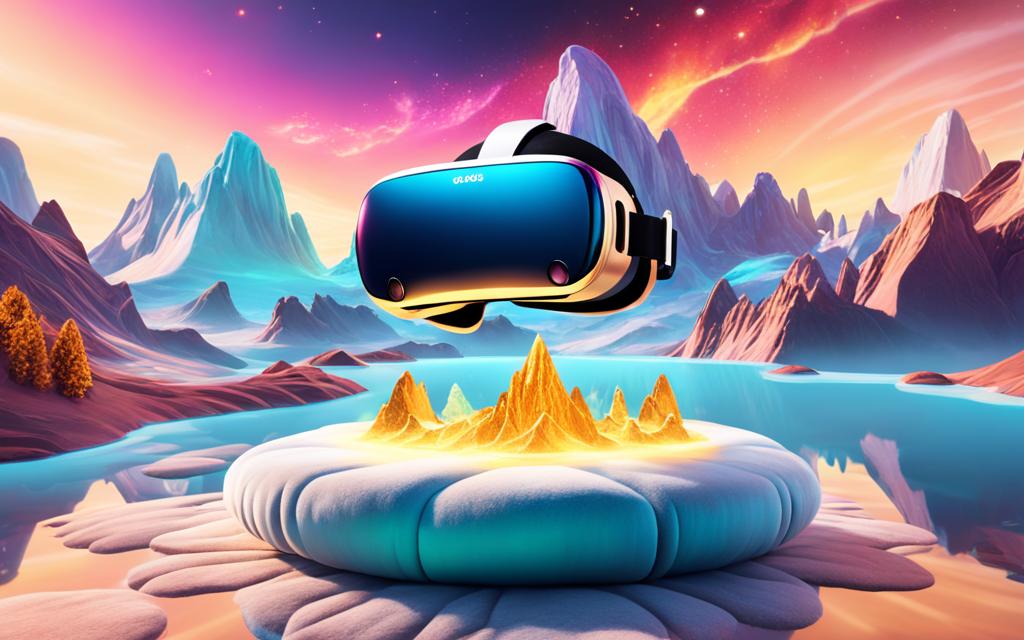Welcome to our exploration of the most exclusive virtual reality experiences in the gaming industry! As technology continues to advance, gamers are now able to immerse themselves in a whole new level of interactive gameplay. From captivating storytelling to cutting-edge graphics, virtual reality offers gamers an unparalleled level of immersion and excitement.
Join us as we dive into the world of virtual reality gaming and uncover the most exclusive experiences available. From heart-pounding adventures to mind-bending puzzles, these immersive gaming experiences are sure to leave you breathless. Get ready to step into a virtual world where the boundaries of reality are blurred and the possibilities are endless.
Key Takeaways:
- Virtual reality gaming offers a level of immersion and excitement that is unparalleled.
- The most exclusive virtual reality experiences in gaming take players on heart-pounding adventures and mind-bending puzzles.
- With cutting-edge graphics and captivating storytelling, virtual reality gaming blurs the boundaries of reality.
Immersive Beginnings: The Rise of Virtual Reality in Gaming
The gaming industry has been forever transformed by the rise of virtual reality (VR) technology. Over the years, VR has emerged as a prominent feature, revolutionizing the way gamers experience their favorite titles. From early prototypes to the advanced VR headsets we have today, the journey of virtual reality in gaming has been nothing short of extraordinary.
Virtual reality technology has come a long way since its inception. It has been embraced by both developers and gamers alike, offering an immersive gaming experience like no other. The rise of VR in gaming can be attributed to several factors, including technological advancements, increased accessibility, and a growing demand for more interactive and realistic gameplay.
Early virtual reality concepts paved the way for the groundbreaking experiences we have today. Innovators like Oculus and HTC played a significant role in introducing consumer-ready VR headsets, allowing gamers to step into virtual worlds and interact with them in ways previously unimaginable.
The gaming industry quickly recognized the potential of virtual reality technology and began developing games specifically designed for VR. These immersive gaming experiences provide players with a sense of presence, transporting them into virtual environments where they can explore, solve puzzles, and engage in thrilling adventures.
“Virtual reality is poised to redefine the way we play games, offering an unparalleled level of immersion and interactivity that enhances the overall gaming experience.”
As VR technology continues to evolve, developers are pushing the boundaries of what is possible in gaming. They are leveraging advanced graphics, realistic physics, and intuitive controls to create truly immersive and captivating experiences. Whether it’s exploring fantasy worlds, piloting a virtual spaceship, or engaging in intense multiplayer battles, VR gaming allows players to engage with the game world on a whole new level.
The rise of virtual reality in gaming has not only transformed the way we play games but has also opened up new opportunities for developers and gamers alike. The potential of VR extends beyond entertainment, with applications in various industries such as education, healthcare, and training.
As we continue to witness the rise of virtual reality in gaming, it is clear that we are entering a new era of immersive gameplay. The possibilities are endless, and the future looks incredibly exciting for both developers and gamers.
In the next section, we will explore the basics of virtual reality and what sets it apart in interactive entertainment.
Exploring the Basics: What Sets VR Apart in Interactive Entertainment
Definition of Interactive Entertainment
With the integration of advanced technologies, interactive entertainment has evolved into a dynamic and immersive medium that captivates audiences like never before. Whether it’s engaging in interactive gaming experiences or exploring virtual environments, interactive entertainment offers a level of engagement and interactivity that traditional forms of entertainment cannot match. Virtual reality (VR) is at the forefront of this revolution, bringing a new dimension to interactive entertainment.
The Evolution from AR to Ultimate VR Experiences
Before delving into the details of virtual reality, it’s essential to understand its journey from augmented reality (AR) to becoming the ultimate immersive experience. Augmented reality overlays digital elements on the real world, enhancing everyday experiences. However, virtual reality takes it a step further by transporting users to entirely digital environments, creating a sense of presence and immersion. Through the use of VR headsets, users can explore virtual worlds, interact with objects, and engage in simulated experiences that blur the line between the real and virtual.
VR experiences offer a level of interactivity and immersion that makes them stand out in the realm of interactive entertainment. By creating lifelike environments and providing users with a sense of agency, VR gaming enables players to become an active part of the digital world. From exploring awe-inspiring landscapes to engaging in heart-pounding adventures, VR experiences transport players to new dimensions of interactive gaming.
To visualize the evolution of interactive entertainment, take a look at the table below:
| Interactive Entertainment | Augmented Reality (AR) | Virtual Reality (VR) |
|---|---|---|
| Definition | Enhances real-world experiences with digital overlays. | Transports users to entirely digital environments for immersive experiences. |
| Interactivity | Overlapping digital elements in the real world. | Full immersion and interactivity in digital environments. |
| Experience | Enhanced real-world experiences with digital elements. | Complete immersion in virtual environments. |
| Impact | Enhanced everyday experiences. | Ultimate immersion and gaming experiences. |
As the table illustrates, the evolution from augmented reality to virtual reality has revolutionized the landscape of interactive entertainment. VR experiences have carved a niche for themselves by offering unparalleled interactivity, immersion, and awe-inspiring adventures. With the continued advancements in VR technology and the boundless creativity of developers, the future of interactive entertainment holds even more exciting possibilities.

By exploring the basics of virtual reality and understanding its evolution from augmented reality, we can comprehend the unique aspects that set VR apart in the realm of interactive entertainment. The immersive nature, interactivity, and limitless possibilities of VR gaming make it a truly extraordinary experience for enthusiasts and gamers alike. So, put on your VR headset and get ready to embark on unforgettable virtual journeys.
Current Standouts: Today’s Pioneers of VR Gaming
In the rapidly evolving world of virtual reality gaming, there are certain developers and games that stand out as the current pioneers of the industry. These leading VR games and developers are pushing the boundaries of virtual reality experiences, creating innovative and captivating gameplay that truly immerses players in their virtual worlds.
One such standout is Half-Life: Alyx, developed by Valve Corporation. This highly anticipated VR game takes players back into the iconic Half-Life universe, delivering an unrivaled level of interactivity and immersion. With its groundbreaking gameplay mechanics and stunning visuals, Half-Life: Alyx sets a new standard for what is possible in VR gaming.
Another notable pioneer is Beat Saber, a rhythm-based game developed by Beat Games. This addictive VR experience combines music, lightsabers, and precision slicing movements to create an exhilarating gameplay experience. With a wide range of songs and custom levels, Beat Saber has become a staple in VR gaming and continues to captivate players around the world.
The Walking Dead: Saints & Sinners, developed by Skydance Interactive, is another leading VR game that offers an immersive and intense survival experience set in the zombie-infested world of The Walking Dead. With its realistic physics, challenging gameplay, and rich storytelling, this game pushes the boundaries of what VR gaming can deliver.
These are just a few examples of the current pioneers in VR gaming. From the innovative gameplay mechanics of Superhot VR to the immersive storytelling of Lone Echo, these games and developers are continuously pushing the boundaries and redefining what is possible in virtual reality.
As VR technology continues to advance, we can expect even more groundbreaking and innovative experiences from these current pioneers and the emerging talents in the VR gaming industry. The future of VR gaming is filled with endless possibilities, and these leading games and developers are at the forefront of shaping that future.
Gaming Industry Trends: Shaping the Future of Virtual Experiences
In today’s rapidly evolving gaming industry, keeping up with the latest trends is essential to stay ahead of the curve. As technology continues to advance, virtual experiences are becoming increasingly immersive and engaging, revolutionizing the way we play games. In this section, we will explore the gaming industry trends that are shaping the future of virtual experiences and the exciting possibilities they bring.
Technological Innovations Poised to Enhance VR Gaming
Technological innovations are driving the evolution of virtual reality gaming. Improved graphics, haptic feedback, and augmented reality integration are just a few of the innovations that are transforming the gaming experience. The advancement of graphics technology allows for more realistic and detailed virtual worlds, immersing players in breathtaking visuals. Haptic feedback technology enhances immersion by providing tactile sensations, making players feel the impact of in-game actions. Augmented reality integration takes VR gaming to another level, merging virtual and real-world elements for a blended and seamless experience.
These technological innovations not only enhance the immersion but also open up new possibilities for gameplay mechanics and storytelling. Developers are exploring innovative ways to integrate these technologies into their games, creating unique and unforgettable experiences for players.
New Frontiers: Market Size and Consumer Appetite
The market size for virtual experiences is expanding rapidly, fueled by the growing consumer appetite for immersive gaming. As more players recognize the potential of virtual reality, the demand for VR games and experiences continues to rise. According to industry reports, the global VR gaming market is projected to reach a market size of $45.09 billion by 2027, with a compound annual growth rate of XX% from 2020 to 2027.
This increasing market size is driven by the growing consumer appetite for virtual experiences that offer a level of immersion and escapism unmatched by traditional gaming. Players are seeking complete sensory experiences that transport them to new worlds and allow them to interact with their surroundings in unprecedented ways. From exploring ancient civilizations to battling alien creatures, VR gaming offers an unparalleled level of immersion that captivates and entertains players.
Furthermore, the appetite for virtual experiences extends beyond traditional gamers, with a broader audience embracing VR for entertainment, education, and professional training purposes. This diverse range of applications contributes to the expansion of the market and paves the way for innovative experiences beyond gaming.

The Developers’ Chronicle: Crafting Next-Gen VR Games
In the world of virtual reality, game development takes on a whole new level of complexity and innovation. Developers are tasked with crafting next-generation VR games that offer immersive and captivating experiences for players. In this section, we will dive into the game development process for virtual reality and explore the unique challenges and considerations that developers face.
VR game development starts with a concept, where ideas are brainstormed and refined. The focus is on creating a game that leverages the unique features and capabilities of virtual reality technology to provide an immersive and interactive experience. From there, the design phase begins, where the visual elements, user interface, and gameplay mechanics are meticulously crafted to ensure a seamless and enjoyable experience.
One of the key considerations in VR game development is optimizing the game for performance and comfort. Virtual reality requires high frame rates and low latency to avoid motion sickness and provide a smooth experience. Developers must carefully balance graphical fidelity with performance to create visually stunning games that run smoothly on VR hardware.
Testing is a crucial part of the game development process for VR games. Developers need to ensure that the game works seamlessly across different VR platforms and devices, accounting for variations in hardware capabilities and tracking systems. Immersion and comfort are also tested and refined to provide players with the most immersive and comfortable experience possible.
When it comes to VR game design, user interaction and engagement are paramount. Developers have the opportunity to create innovative and intuitive gameplay mechanics that take advantage of virtual reality’s unique affordances. From wielding virtual weapons to solving puzzles with hand gestures, the possibilities are endless.
“VR game development is a constantly evolving field that requires a deep understanding of the technology and the creative vision to push boundaries and deliver unique experiences.” – VR Game Developer
Without a doubt, the developers’ chronicle in crafting next-gen VR games is filled with excitement, challenges, and limitless possibilities. By harnessing the power of VR game development, developers are paving the way for groundbreaking experiences that bring players into new worlds and redefine the way we play.
Unlocking Total Immersion: How VR Technologies Redefine Gameplay
In the world of virtual reality gaming, total immersion is the ultimate goal. It is the seamless integration of technology and gameplay that transports players into another realm, making them feel as though they are truly part of the virtual world. VR technologies play a pivotal role in unlocking this level of immersion, elevating the gaming experience to new heights.
Hardware Capabilities: From Headsets to Haptics
At the core of VR technologies are the hardware capabilities that enable immersive gameplay. VR headsets, such as the Oculus Rift, HTC Vive, and PlayStation VR, provide the visual gateway into virtual worlds. With high-resolution displays and advanced tracking systems, these headsets create a sense of presence that blurs the line between reality and the virtual realm.

But visual immersion is just the beginning. Haptic feedback devices, such as VR gloves and controllers, add a tactile dimension to the gaming experience. They provide a sense of touch and physicality, allowing players to interact with the virtual environment in a more realistic and intuitive way. From feeling the recoil of a virtual gun to the sensation of virtual objects in their hands, haptic feedback enhances the sense of immersion and bridges the gap between the digital and physical worlds.
Creating a Sensory Symphony: The Role of Sound and Touch
Immersive gameplay goes beyond stunning visuals and touch feedback. Sound design also plays a crucial role in creating a sensory symphony that enhances the virtual reality experience. Spatial audio technologies, such as binaural audio, accurately reproduce realistic soundscapes, from footsteps approaching from behind to the echoes of a cavernous environment. These subtle auditory cues deepen the player’s sense of presence and further immerse them in the virtual world.
Furthermore, VR technologies are increasingly incorporating other sensory elements, such as smell and temperature, to elevate the level of immersion. While still in its early stages, these advancements have the potential to further blur the boundaries between reality and virtual reality, creating a truly multisensory gaming experience.
In conclusion, VR technologies redefine gameplay by unlocking total immersion. From VR headsets to haptic feedback devices, these hardware capabilities transport players into virtual worlds. Coupled with immersive sound design and the potential for additional sensory elements, VR technologies continue to push the boundaries of gaming, offering players an unparalleled level of engagement and immersion.
Understanding VR Centricity: User Experience at the Heart
In the realm of virtual reality gaming, one key principle reigns supreme – VR centricity. At the heart of VR centricity is the user experience, which plays a pivotal role in creating truly immersive and enjoyable gaming experiences. Through the application of user-centric design principles, VR games are able to transport players into virtual worlds like never before, offering a level of interactivity and immersion that is unparalleled.
When it comes to user experience in virtual reality gaming, every detail matters. From the moment a player puts on their VR headset, they are transported into a new reality where every movement, sound, and interaction is carefully crafted to engage their senses and enhance their gaming experience. Whether it’s the intuitive controls that allow players to seamlessly navigate virtual environments or the lifelike graphics that bring virtual worlds to life, user-centric design is the driving force behind the success of VR gaming.
One of the key elements of user-centric design in VR gaming is the emphasis on intuitive controls. Unlike traditional gaming, where players rely on controllers or keyboards, VR gaming allows players to physically interact with virtual environments using their own movements and gestures. This level of immersion not only enhances the overall gaming experience but also eliminates barriers between the player and the virtual world, making them feel like an integral part of the game.
“Virtual reality gaming has opened up a whole new world of possibilities for player immersion. By prioritizing the user experience and incorporating intuitive controls, we are able to transport players into virtual worlds like never before.” – Jeff Johnson, VR Game Developer
In addition to intuitive controls, user-centric design in VR gaming also focuses on creating seamless interactions. In traditional gaming, players may need to navigate complex menus or perform multiple steps to perform certain actions. In VR gaming, however, interactions are designed to be natural and seamless, allowing players to perform actions with ease and without breaking the immersion.
Another aspect of user-centric design in VR gaming is the importance of creating a sense of presence. Through realistic graphics, spatial audio, and haptic feedback, VR games strive to create a sensory experience that is as close to real life as possible. This level of immersion not only enhances the gameplay but also evokes emotional responses from players, making the gaming experience more impactful and memorable.
In conclusion, VR centricity places user experience at the heart of virtual reality gaming. By employing user-centric design principles, VR games are able to deliver immersive and enjoyable experiences that transport players into virtual worlds like never before. From intuitive controls to seamless interactions, VR centricity enhances the user experience and sets the stage for the future of immersive gaming.
Strategic Innovations: Expanding VR Beyond Gaming
In the world of virtual reality, innovation knows no bounds. While VR gaming has captured the attention of gamers worldwide, strategic innovations are pushing the boundaries and expanding VR beyond entertainment. In this section, we will explore the exciting applications of VR in education and the transformative power it holds. Additionally, we will delve into the realm of virtual training programs and how they are revolutionizing professional upskilling.
VR in Education: The Next Edutainment Revolution
Education has always been about engaging students and facilitating meaningful learning experiences. With the advent of VR, a new era of education has emerged. VR in education combines entertainment and education, creating immersive environments that captivate students and enhance their understanding of complex subjects. From exploring ancient civilizations to visiting outer space, VR brings learning to life in ways never before possible.
Through the incorporation of edutainment, VR has the ability to provide interactive and engaging educational content, making learning fun and effective. Students can actively participate in virtual simulations, experiments, and scenarios, fostering critical thinking, problem-solving, and experiential learning. By allowing students to become active participants in their own education, VR in education is reshaping the traditional classroom experience.
Professional Upskilling Through Virtual Training Programs
Beyond the realm of education, VR is making waves in professional training and upskilling. Virtual training programs are revolutionizing the way individuals acquire new skills and knowledge in various industries. Whether it’s medical training, aviation simulation, or honing technical skills, VR offers a safe, realistic, and immersive environment for professionals to practice and refine their expertise.
Virtual training programs not only provide hands-on experience but also save time, cost, and resources compared to traditional training methods. Individuals can undergo training without the need for physical equipment or risking real-life consequences. With virtual simulations, professionals can learn from their mistakes and gain confidence in their abilities, ensuring a higher level of competence and preparedness in their respective fields.

| Benefits of VR in Education | Benefits of Virtual Training Programs |
|---|---|
|
|
As strategic innovations continue to push the boundaries of VR, the applications of virtual reality in education and professional training will only continue to expand. From revolutionizing the way students learn to empowering professionals to upskill, VR is transforming these domains and shaping the future of education and training.
Accessibility and Inclusion: Broadening the VR Gaming Audience
In the world of virtual reality gaming, accessibility and inclusion play crucial roles in broadening the VR gaming audience. Advancements in VR technology have opened up new possibilities, making gaming more accessible to a wider range of individuals, including those with disabilities. VR has the power to create immersive experiences that cater to diverse gaming preferences and foster a sense of inclusivity.
One of the key benefits of virtual reality is its ability to level the playing field for gamers with disabilities. VR headsets and controllers provide alternative input methods that accommodate different physical abilities, allowing individuals to fully engage in gaming experiences. For example, individuals with limited mobility can utilize hand tracking or voice recognition to navigate and interact within virtual environments, providing them with a sense of agency and equal participation.
Moreover, VR allows for the creation of diverse gaming experiences that cater to a wide variety of interests and identities. In virtual reality, players can explore fantastical worlds, engage in adrenaline-pumping adventures, or participate in immersive storytelling that reflects their unique perspectives. By embracing and celebrating diversity in virtual reality, game developers can broaden their audience and ensure that everyone feels represented and welcomed.
“Virtual reality has the potential to break down barriers and create a more inclusive gaming landscape, where individuals of all backgrounds can come together and share memorable experiences.”
In order to achieve true accessibility and inclusion, it is important for game developers to prioritize user-centric design principles. This involves considering the needs and preferences of different individuals throughout the development process. By implementing accessibility features, such as customizable controls and adjustable difficulty levels, developers can ensure that their VR games are accessible to as many people as possible.
| Benefits of Accessibility and Inclusion in VR Gaming | Examples |
|---|---|
| Enhances the gaming experience for individuals with disabilities | Customizable controls for players with limited mobility |
| Expands the target audience for VR games | Representation of diverse identities and experiences |
| Creates a more inclusive gaming community | Accessible gameplay options that cater to different skill levels |
By prioritizing accessibility and inclusion in VR gaming, developers have the opportunity to create a more inclusive and diverse gaming landscape. This not only benefits individuals with disabilities but also expands the potential audience for VR games. As technology continues to advance, it is crucial that we continue to push for greater accessibility and inclusion in order to ensure that everyone can enjoy the immersive experiences that virtual reality has to offer.
From Test Labs to Game Rooms: Quality Assurance in VR Gaming
In the world of virtual reality gaming, quality assurance plays a crucial role in ensuring a seamless and immersive experience for players. As VR technology continues to evolve, it becomes increasingly important to prioritize performance excellence and comfort in VR testing.
Performance Excellence for Seamless Play
When it comes to VR gaming, performance is key. This is why rigorous performance testing is a fundamental part of quality assurance in VR gaming. By thoroughly testing the performance of VR games, developers can identify and address any issues that may hinder smooth gameplay and overall user experience.
To achieve performance excellence, VR games undergo extensive testing in various areas such as frame rate optimization, latency reduction, and visual fidelity. By optimizing these aspects, developers can ensure that players can enjoy a seamless and immersive gameplay environment.
Additionally, performance testing helps in detecting and eliminating motion sickness-inducing factors. By carefully analyzing and optimizing movement mechanics, developers can enhance comfort levels and ensure that players can enjoy VR gaming without any discomfort or unwanted side effects.
Ensuring Comfort and Reducing Barriers in VR Testing
In VR testing, comfort is a critical consideration. By prioritizing comfort, developers can create an enjoyable experience for players that promotes extended play sessions. Comfortable VR gaming experiences reduce fatigue, eye strain, and other physical discomforts that may arise from prolonged use of VR headsets and devices.
Moreover, reducing barriers to entry is essential in VR testing. By considering the diverse needs and abilities of players, developers can ensure that their games are accessible and inclusive for everyone. This includes designing VR experiences with customizable options for comfort settings, locomotion methods, and accessibility features.
Overall, by focusing on quality assurance, VR developers can not only enhance the performance and comfort of their games but also create experiences that appeal to a wider audience. As the VR gaming industry continues to grow and evolve, the role of quality assurance becomes increasingly crucial in delivering top-notch virtual reality experiences.

The Analytics of Amusement: Tracking Esports Growth and VR Influence
In this section, we will delve into the analytics of amusement by tracking the growth of esports and the influence of VR in the gaming industry. By analyzing data and trends, we can gain valuable insights into the rising popularity and revenue generated by competitive gaming. Additionally, we will explore how VR technology is shaping the gaming landscape and its impact on the future of esports.
To understand the growth of esports, we will examine key analytics such as viewership, revenue, and participation rates. Esports has experienced tremendous growth in recent years, with millions of viewers tuning in to watch professional tournaments and events. This surge in popularity has not only attracted a large audience but has also led to increased investment and sponsorship opportunities within the industry.
The influence of VR in the gaming industry cannot be ignored. Virtual reality has revolutionized the gaming experience, offering immersive and interactive gameplay like never before. With the ability to transport players into virtual worlds, VR technology provides a level of realism and engagement that traditional gaming cannot replicate. As a result, VR is reshaping the future of esports, with the potential to create entirely new competitive gaming experiences.

Conclusion
Throughout this article, we have explored the most exclusive virtual reality experiences in gaming and the future of the VR gaming industry. We have witnessed the rise of virtual reality and its transformation from a mere concept to a groundbreaking technology that has reshaped the gaming landscape.
From immersive gameplay to cutting-edge graphics, virtual reality has revolutionized the way we experience games. We have showcased the current pioneers of VR gaming, who continue to push the boundaries of innovation and deliver captivating storytelling and innovative gameplay mechanics.
As we look to the future, it is clear that virtual reality will continue to shape the gaming industry. With technological advancements, we can expect improved graphics, haptic feedback, and augmented reality integration, enhancing the immersive experience for gamers. The market size for virtual experiences is expanding, reflecting the growing consumer appetite for the unique and unparalleled experiences that VR gaming provides.
In conclusion, virtual reality has become synonymous with immersive entertainment, offering gamers a gateway to worlds beyond imagination. The possibilities are endless, and the future of VR gaming holds tremendous potential for both developers and gamers alike. With VR centricity, accessibility, and inclusive gaming experiences, virtual reality is poised to redefine the way we play and interact with games. As the VR industry continues to evolve, we eagerly anticipate the exciting developments and innovations that lie ahead.
